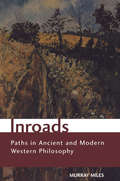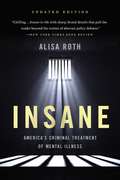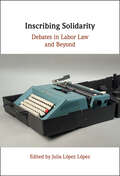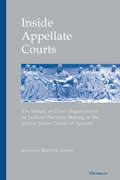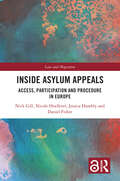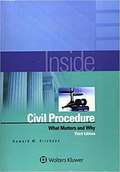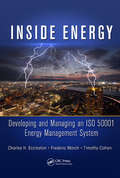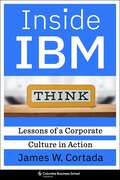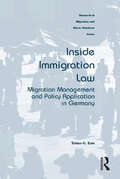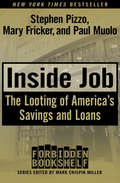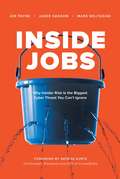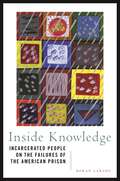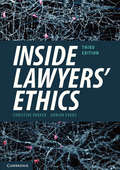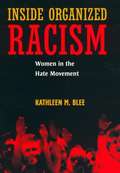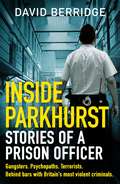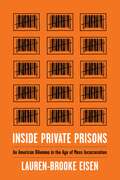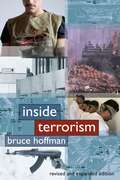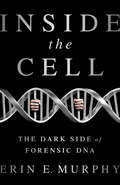- Table View
- List View
Inroads
by Murray MilesThis unique introduction to philosophy is designed as a companion volume to a number of classic philosophical texts widely used in first- and upper-year philosophy courses. While remaining clear and readable, Inroads provides detailed analyses of fundamental issues in metaphysics and morals: the existence of God, the meaning of death, and the elements and definitions of the 'good life' for humankind.Combining a historical with a systematic approach, Murray Miles's work straddles the customary divisions between ancient and modern, and Anglo-American and continental European philosophy. In each of its five main parts - in turn, focusing on Socrates, Plato, Descartes, Hume, and Sartre - Inroads discusses, from a philosophical rather than a religious or scientific perspective, those questions that make up the common inheritance of academic philosophy and ethico-religious thought. Other features include a detailed glossary of philosophical terms, suggestions for further reading, and questions for reflection and review. Inroads is a useful text for first-year undergraduate courses or, equally, a sound resource for the general reader looking for a good grounding in philosophy and its history.
Insane: America's Criminal Treatment of Mental Illness
by Alisa RothAn urgent exposé of the mental health crisis in our courts, jails, and prisonsAmerica has made mental illness a crime. Jails in New York, Los Angeles, and Chicago each house more people with mental illnesses than any hospital. As many as half of all people in America's jails and prisons have a psychiatric disorder. One in four fatal police shootings involves a person with such disorders.In this revelatory book, journalist Alisa Roth goes deep inside the criminal justice system to show how and why it has become a warehouse where inmates are denied proper treatment, abused, and punished in ways that make them sicker.Through intimate stories of people in the system and those trying to fix it, Roth reveals the hidden forces behind this crisis and suggests how a fairer and more humane approach might look. Insane is a galvanizing wake-up call for criminal justice reformers and anyone concerned about the plight of our most vulnerable.
Inscribing Solidarity: Debates in Labor Law and Beyond
by Julia López LópezMany governments, large institutions, and collective actors rely on the principle of solidarity to embed social policies on firm normative and legal grounds. In this original volume, a multidisciplinary roster of scholars come together to examine the contributions – and challenges –implicit in relying on the idea of solidarity to 'inscribe' this principle in social policies. Chapters explore how the dependence on the solidarity principle, and especially on inclusive understandings of solidarity, can strengthen or weaken institutions and movements. The volume's contributors cover developments across decades with a multilevel approach exploring dynamic interactions between local, national, and supranational arenas in pursuing and adjudicating the solidarity principle. Unique and innovative, Inscribing Solidarity examines the implications and dynamics of solidarity across a variety of terrains to illuminate its concrete limitations and specific advantages. This title is also available via Open Access on Cambridge Core.
Insect Media: An Archaeology of Animals and Technology (Posthumanities #11)
by Jussi ParikkaSince the early nineteenth century, when entomologists first popularized the unique biological and behavioral characteristics of insects, technological innovators and theorists have proposed insects as templates for a wide range of technologies. In Insect Media, Jussi Parikka analyzes how insect forms of social organization-swarms, hives, webs, and distributed intelligence-have been used to structure modern media technologies and the network society, providing a radical new perspective on the interconnection of biology and technology.Through close engagement with the pioneering work of insect ethologists, including Jakob von Uexküll and Karl von Frisch, posthumanist philosophers, media theorists, and contemporary filmmakers and artists, Parikka develops an insect theory of media, one that conceptualizes modern media as more than the products of individual human actors, social interests, or technological determinants. They are, rather, profoundly nonhuman phenomena that both draw on and mimic the alien lifeworlds of insects. Deftly moving from the life sciences to digital technology, from popular culture to avant-garde art and architecture, and from philosophy to cybernetics and game theory, Parikka provides innovative conceptual tools for exploring the phenomena of network society and culture. Challenging anthropocentric approaches to contemporary science and culture, Insect Media reveals the possibilities that insects and other nonhuman animals offer for rethinking media, the conflation of biology and technology, and our understanding of, and interaction with, contemporary digital culture.
Inside Al Qaeda: Global Network of Terror
by Rohan GunaratnaInside Al Qaeda examines the leadership, ideology, structure, strategies, and tactics of the most violent politico-religious organization the world has ever seen. The definitive work on Al Qaeda, this book is based on five years of research, including extensive interviews with its members; field research in Al Qaeda-supported conflict zones in Central, South and Southeast Asia and the Middle East; and monitoring Al Qaeda infiltration of diaspora and migrant communities in North America and Europe.Although founded in 1988, Al Qaeda merged with and still works with several other extremist groups. Hence Al Qaeda rank and file draw on nearly three decades of terrorist expertise. Moreover, it inherited a full-fledged training and operational infrastructure funded by the United States, European, Saudi Arabian and other governments for use in the anti-Soviet Jihad.This book sheds light on Al Qaeda's financial infrastructure and how they train combat soldiers and vanguard fighters for multiple guerrilla, terrorist and semi-conventional campaigns in the Middle East, Asia, Africa, the Caucuses, and the Balkans. In addition, the author covers the clandestine Al Qaeda operational network in the West. Gunaratna reveals:how Osama bin Laden had his mentor and Al Qaeda founder, "Azzam", assassinated in order to take over the organization and that other Al Qaeda officers who stood in his way were murdered,Al Qaeda's long-range, deep-penetration agent handling system in Western Europe and North America for setting up safe houses, procuring weapons, and conducting operations,how the O55 Brigade, Al Qaeda's guerrilla organization, integrated into the Taliban,how the arrest of Zacarias Moussaoui forced Al Qaeda to move forward on September 11,how a plan to destroy British Parliament on 9/11 and to use nerve gas on the European Union Parliament were thwarted,how the Iran--Hezbollah--Al Qaeda link provided the knowledge to conduct coordinated, simultaneous attacks on multiple targets, including failed plans to destroy Los Angeles International Airport, the USS Sullivan, the Radisson Hotel in Jordan, and eleven US commercial airliners over the Pacific ocean,that one-fifth of international Islamic charities and NGOs are infiltrated by Al Qaeda,how the US response is effective militarily in the short term, but insufficient to counter Al Qaeda's ideology in the long-term.Finally, to destroy Al Qaeda, Gunaratna shows there needs to be a multipronged, multiagency, and multidimensional response by the international community.
Inside Appellate Courts: The Impact of Court Organization on Judicial Decision Making in the United States Courts of Appeals
by Jonathan Matthew CohenInside Appellate Courts is a comprehensive study of how the organization of a court affects the decisions of appellate judges. Drawing on interviews with more than seventy federal appellate judges and law clerks, Jonathan M. Cohen challenges the assumption that increasing caseloads and bureaucratization have impinged on judges' abilities to bestow justice. By viewing the courts of appeals as large-scale organizations, Inside Appellate Courts shows how courts have walked the tightrope between justice and efficiency to increase the number of cases they decide without sacrificing their ability to dispense a high level of justice. Cohen theorizes that, like large corporations, the courts must overcome the critical tension between the autonomy of the judges and their interdependence and coordination. However, unlike corporations, courts lack a central office to coordinate the balance between independence and interdependence. Cohen investigates how courts have dealt with this tension by examining topics such as the role of law clerks, methods of communication between judges, the effect of a court's size and geographic location, the role of argumentation, the use of visiting judges, the significance of the increasing use of unpublished decisions, and the nature and role of court culture.
Inside Apple: Das Erfolgsgeheimnis des wertvollsten, innovativsten und verschwiegensten Unternehmensder Welt
by Adam LashinskyApple ist seit dem 20. August 2012 das wertvollste Unternehmen der Welt. "Inside Apple" enthüllt das geheime System, die Taktiken und die Führungsstrategien, die Steve Jobs und seinem Unternehmen erlaubten, ein Erfolgsprodukt nach dem anderen zu produzieren und eine kultähnliche Anhängerschaft für seine Produkte zu erwecken. In diesem Referenzwerk zur Unternehmensführung stellt Adam Lashinsky dem Leser Konzepte wie das des "DRI" (Apples Praxis, jeder Aufgabe einen "Directly Responsible Individual", also einen direkt und unmittelbar Verantwortlichen zuzuweisen) und das der Top 100 (ein jährlich wiederkehrendes Ritual, bei dem 100 aufstrebende Führungskräfte für ein geheimes, vollständig abgeschirmtes Treffen mit Unternehmensgründer Steve Jobs ausgewählt und auf Herz und Nieren überprüft werden) vor. Basierend auf zahllosen Interviews bietet das Buch exklusiv neue Informationen darüber, wie Apple Innovationen schafft, mit Lieferanten umgeht und den Übergang in die Post-Jobs-Ära handhabt. Adam Lashinsky kennt Apple durch und durch: Bereits 2008 sagte er in einer Titelstory ("The Genius Behind Steve: Could Operations Whiz Tim Cook Run The Company Someday?") für das Magazin Fortune voraus, dass der damals noch unbekannte Tim Cook eventuell Steve Jobs als CEO nachfolgen würde. Obwohl "Inside Apple" vordergründig ein tiefer Einblick in ein einzigartiges Unternehmen (und in sein Ökosystem aus Lieferanten, Investoren, Angestellten und Wettbewerbern) ist, sind die Lehren über Steve Jobs, Unternehmensführung, Produktdesign und Marketing allgemeingültig. Sie sollten von jedem gelesen werden, der einen Teil der Apple-Magie in sein Unternehmen, seine Karriere oder sein kreatives Bestreben bringen möchte.
Inside Asylum Appeals: Access, Participation and Procedure in Europe (Law and Migration)
by Daniel Fisher Nick Gill Nicole Hoellerer Jessica HamblyAppeals are a crucial part of Europe’s asylum system but they remain poorly understood. Building on insights and perspectives from legal geography and socio-legal studies, this book shines a light on what takes place during asylum appeals and puts forward suggestions for improving their fairness and accessibility. Drawing on hundreds of ethnographic observations of appeal hearings, as well as research interviews, the authors paint a detailed picture of the limitations of refugee protection available through asylum appeals. Refugee law can appear dependable and reliable in policy documents and legal texts. However, this work reveals that, in reality, myriad social, political, psychological, linguistic, contextual and economic factors interfere with and frequently confound the protection that refugee law promises during its concrete enactment. Drawing on evidence from Austria, Belgium, France, Germany, Greece, Italy and the United Kingdom, the book equips readers with a clear sense of the fragility of legal protection for people forced to migrate to Europe. The book will appeal to scholars of migration studies, legal studies, legal geography and the social sciences generally, as well as practitioners in asylum law throughout Europe and beyond.This book is freely available as a downloadable Open Access PDF at http://www.taylorfrancis.com under a Creative Commons Attribution-Non Commercial-No Derivatives (CC-BY-NC-ND) 4.0 license.
Inside Civil Procedure: What Matters and Why (Inside)
by Howard M. Nbsp Nbsp ErichsonInside Civil Procedure: What Matters and Why, like a great teacher, helps law students understand civil procedure clearly and deeply. Procedural rules and doctrines that at first seem incomprehensible finally make sense when students understand what the rules are trying to do, how they are used in practice, and how they fit into the bigger picture. <p><p> Unlike oversimplified outlines or lengthy treatises, it actually teaches with clear explanations and features designed to help students master the material. By the end of each chapter, students will have a clear understanding of not only how the rules and doctrines work, but also how the pieces of the puzzle fit together.
Inside Energy: Developing and Managing an ISO 50001 Energy Management System
by Charles H. Eccleston Frederic March Timothy CohenInformed by the authors' extensive experience in helping organizations improve the performance of their management systems, Inside Energy: Developing and Managing an ISO 50001 Energy Management System covers how to apply each of the many requirements of the standard in a systematic and comprehensive manner. It discusses how converting an existing s
Inside Ethics: On the Demands of Moral Thought
by Alice CraryAlice Crary offers a transformative account of moral thought about human beings and animals. Instead of assuming that the world places no demands on our moral imagination, she underscores the urgency of treating the exercise of moral imagination as necessary for arriving at an adequate world-guided understanding of human beings and animals.
Inside IBM: Lessons of a Corporate Culture in Action
by James W. CortadaIBM was the world’s leading provider of information technologies for much of the twentieth century. What made it so successful for such a long time, and what lessons can this iconic corporation teach present-day enterprises?James W. Cortada—a business historian who worked at IBM for many years—pinpoints the crucial role of IBM’s corporate culture. He provides an inside look at how this culture emerged and evolved over the course of nearly a century, bringing together the perspectives of employees, executives, and customers around the world. Through a series of case studies, Inside IBM explores the practices that built and reinforced organizational culture, including training of managers, employee benefits, company rituals, and the role of humor. It also considers the importance of material culture, such as coffee mugs and lapel pins.Cortada argues that IBM’s corporate culture aligned with its business imperatives for most of its history, allowing it to operate with a variety of stakeholders in mind and not simply prioritize stockholders. He identifies key lessons that managers can learn from IBM’s experience and apply in their own organizations today. This engaging and deeply researched book holds many insights for business historians, executives and managers concerned with stakeholder relations, professionals interested in corporate culture, and IBMers.
Inside Immigration Law: Migration Management and Policy Application in Germany
by Tobias G. EuleInside Immigration Law analyses the practice of implementing immigration law, examining the different political and organisational forces that influence the process. Based on unparalleled academic access to the German migration management system, this book provides new insights into the ’black box’ of regulating immigration, revealing how the application of immigration law to individual cases can be chaotic, improvised and sometimes arbitrary, and either informed or distorted by the complex, politically laden and changeable nature of both German and EU immigration laws. Drawing on extensive empirical material, including participant observation, interviews and analyses of public as well as confidential documents in German immigration offices, Inside Immigration Law unveils the complex practices of decision-making and work organisation in a politically contested environment. A comparative, critical evaluation of the work of offices that examines the discretion and client interactions of bureaucrats, the management of legal knowledge and symbolism and the relationships between immigration offices and external political forces, this book will be of interest to sociologists, legal scholars and political scientists working in the areas of migration, integration and the study of work and organisations.
Inside Job: The Looting of America's Savings and Loans (Forbidden Bookshelf #16)
by Paul Muolo Stephen Pizzo Mary FrickerA fast-paced and gripping account of one of history's most infamous financial disasters For most of the 20th century, savings and loans were an invaluable thread of the American economy. But in the 1970s, Congress passed sweeping financial deregulation at the insistence of industry insiders that allowed these once quaint and useful institutions to spread their taxpayer-insured assets into new and risky investments. The looser regulations and reduced federal oversight also opened the industry to an army of shady characters, white-collar criminals, and organized crime groups. Less than 10 years later, half the nation's savings and loans were insolvent, leaving the American taxpayer on the hook for a large hunk of the nearly half a trillion dollars that had gone missing. The authors of Inside Job saw signs of danger long before the scandal hit nationwide. Decades after the savings and loan collapse, Inside Job remains a thrilling read and a sobering reminder that our financial institutions are more fragile than they appear.
Inside Jobs: Why Insider Risk Is the Biggest Cyber Threat You Can't Ignore
by Joe Payne Jadee Hanson Mark WojtasiakFrom data security company Code42, Inside Jobs offers companies of all sizes a new way to secure today&’s collaborative cultures—one that works without compromising sensitive company data or slowing business down. Authors Joe Payne, Jadee Hanson, and Mark Wojtasiak, seasoned veterans in the cybersecurity space, provide a top-down and bottom-up picture of the rewards and perils involved in running and securing organizations focused on rapid, iterative, and collaborative innovation. Modern day data security can no longer be accomplished by &“Big Brother&” forms of monitoring or traditional prevention solutions that rely solely on classification and blocking systems. These technologies frustrate employees, impede collaboration, and force productivity work-arounds that risk the very data you need to secure. They provide the illusion that your trade secrets, customer lists, patents, and other intellectual property are protected. That couldn&’t be farther from the truth, as insider threats continue to grow. These include: Well-intentioned employees inadvertently sharing proprietary dataDeparting employees taking your trade secrets with them to the competitionA high-risk employee moving source code to an unsanctioned cloud service What&’s the solution? It&’s not the hunt for hooded, malicious wrongdoers that you might expect. The new world of data security is built on security acting as an ally versus an adversary. It assumes positive intent, creates organizational transparency, establishes acceptable data use policies, increases security awareness, and provides ongoing training. Whether you are a CEO, CIO, CISO, CHRO, general counsel, or business leader, this book will help you understand the important role you have to play in securing the collaborative cultures of the future.
Inside Knowledge: Incarcerated People on the Failures of the American Prison
by Doran LarsonA powerful critique of mass incarceration by the people who have experienced itInside Knowledge is the first book to examine the American prison system through the eyes of those who are trapped within it. Drawing from the writings collected in the American Prison Writing Archive, Doran Larson deftly illustrates how mass incarceration does less to contain any harm perpetrated by convicted people than to spread and perpetuate harm among their families and communities.Inside Knowledge makes a powerful argument that America’s prisons not only degrade and debilitate their wards but also defeat the prison’s cardinal missions of rehabilitation, containment, deterrence, and even meaningful retribution. If prisons are places where convicted people are sent to learn a lesson, then imprisoned people are the ones who know just what American prisons actually teach. At once profound and devastating, Inside Knowledge is an invaluable resource for those interested in addressing mass incarceration in America.
Inside Lawyers' Ethics
by Christine Parker Adrian EvansLegal ethics is often described as an oxymoron or contradiction in terms - lay people find the concept amusing and lawyers can find ethics impossible. The best lawyers are those who have come to grips with their own values and actively seek to improve their ethical practise. This book is designed to help law students and new lawyers understand and modify their own ethical priorities, not just because this knowledge makes it easier to practise law and earn an income, but because self-aware, ethical legal practice is right and feels better than anything else. Packed with case studies of ethical scandals and dilemmas from real life legal practice in Australia, each chapter delves into the most difficult issues lawyers face. From lawyers' part in corporate fraud to the ethics of time-based billing, Parker and Evans expose the values that underlie current practice and set out the alternatives ethical lawyers might follow.
Inside Lawyers' Ethics
by Christine Parker Adrian EvansThe third edition of Inside Lawyers' Ethics offers an engaging and practical examination of the moral and ethical dilemmas that legal professionals may encounter in a rapidly changing professional environment. The text provides comprehensive coverage and analysis of general philosophical approaches to morality as well as the legal frameworks which govern ethical decision-making and practice. This new edition has been thoroughly updated and provides in-depth coverage of the Australian Solicitors' Conduct Rules (ASCR) to enable readers to successfully understand, analyse and apply guiding ethical frameworks. Case studies and discussion questions in each chapter provide practical examples from case law, legal practice and research to illustrate common challenges and explain how ethical and moral principles can be applied to a variety of common scenarios. Written by leading academics in the field, this essential text equips readers with the skills to enact ethical behaviours and confidently confront common ethical challenges in their everyday practice.
Inside Organized Racism: Women in the Hate Movement
by Kathleen M. BleeKathleen M. Blee's disturbing and provocative look at the hidden world of organized racism focuses on women, the newest recruiting targets of racist groups and crucial to their campaign for racial supremacy. Through personal interviews with women active in the Ku Klux Klan, neo-Nazi groups, Christian Identity sects, and white power skinhead gangs across the United States, Blee dispels many misconceptions of organized racism. Women are seldom pushed into the racist movement by any compelling interest, belief, or need, she finds. Most are educated. Only the rare woman grew up poor. Most were not raised in abusive families. Most women did not follow men into the world of organized racism. "Inside Organized Racism" offers a fascinating examination of the submerged social relations and the variety of racist identities that lie behind the apparent homogeneity of the movement. Following up her highly praised study of the women in the 1920s Ku Klux Klan, Blee discovers that many of today's racist women combine dangerous racist and anti-Semitic agendas with otherwise mainstream lives. Few of the women she interviews had strong racist or anti-Semitic views before becoming associated with racist groups. Rather, they learned a virulent hatred of racial minorities and anti-Semitic conspiratorial beliefs by being in racist groups. The only national sample of a broad spectrum of racist activists and the only major work on women racists, this well written and important book also sheds light on how gender relationships shape participation in the movement as a whole.
Inside Parkhurst: Stories of a Prison Officer
by David BerridgeAssaults. Riots. Cell fires. Medical emergencies. Understaffed wings. Suicides. Hooch. Weapons. It's all in a week's work at HMP Parkhurst.After 28 years working as a prison officer, with 22 years at HMP Parkhurst, once one of Britain's most high security prisons, David Berridge has had to deal with it all: serial killers and gangsters, terrorists and sex offenders, psychopaths and addicts. InsideParkhurst is his raw, uncompromising look at what really goes on behind the massive walls and menacing gates. Thrown in at the deep end, David quickly had to work out how to deal with the most cunning and volatile of prisoners, and learn how to avoid their many scams. He has been assaulted and abused; he has tackled cell fires and attempted suicides, riots and dirty protests; he has helped to foil escaped plans, talked inmates down from rooftop protests, witnessed prisoners setting fire to themselves, and prevented prisoners from attempting to murder other prisoners. And now he takes us inside this secret world for the first time.With this searingly honest account he guides us around the wings, the segregation unit, the hospital and the exercise yard, and gives vivid portraits of the drug taking, the hooch making, the constant and irrepressible violence, and the extraordinary lengths our prison officers go to everyday. Divided into three parts - the first from David's early years on the wings, the second the middle of his career, and the third his disillusioned later years - David will take readers into the heart of life inside and shine a light on the escalating violence and the impact the government cuts are having on the wings.Both horrifying and hilarious, David's diaries are guaranteed to shock and entertain in equal measure.
Inside Parkhurst: Stories of a Prison Officer
by David BerridgeAssaults. Riots. Cell fires. Medical emergencies. Understaffed wings. Suicides. Hooch. Weapons. It's all in a week's work at HMP Parkhurst.After 28 years working as a prison officer, with 22 years at HMP Parkhurst, once one of Britain's most high security prisons, David Berridge has had to deal with it all: serial killers and gangsters, terrorists and sex offenders, psychopaths and addicts. Inside Parkhurst is his raw, uncompromising look at what really goes on behind the massive walls and menacing gates. Thrown in at the deep end, David quickly had to work out how to deal with the most cunning and volatile of prisoners, and learn how to avoid their many scams. He has been assaulted and abused; he has tackled cell fires and attempted suicides, riots and dirty protests; he has helped to foil escaped plans, talked inmates down from rooftop protests, witnessed prisoners setting fire to themselves, and prevented prisoners from attempting to murder other prisoners. And now he takes us inside this secret world for the first time.With this searingly honest account he guides us around the wings, the segregation unit, the hospital and the exercise yard, and gives vivid portraits of the drug taking, the hooch making, the constant and irrepressible violence, and the extraordinary lengths our prison officers go to everyday. Divided into three parts - the first from David's early years on the wings, the second the middle of his career, and the third his disillusioned later years - David will take readers into the heart of life inside and shine a light on the escalating violence and the impact the government cuts are having on the wings.Both horrifying and hilarious, David's diaries are guaranteed to shock and entertain in equal measure.
Inside Private Prisons: An American Dilemma in the Age of Mass Incarceration
by Lauren-Brooke EisenWhen the tough-on-crime politics of the 1980s overcrowded state prisons, private companies saw potential profit in building and operating correctional facilities. Today more than a hundred thousand of the 1.5 million incarcerated Americans are held in private prisons in twenty-nine states and federal corrections. Private prisons are criticized for making money off mass incarceration—to the tune of $5 billion in annual revenue. Based on Lauren-Brooke Eisen’s work as a prosecutor, journalist, and attorney at policy think tanks, Inside Private Prisons blends investigative reportage and quantitative and historical research to analyze privatized corrections in America.From divestment campaigns to boardrooms to private immigration-detention centers across the Southwest, Eisen examines private prisons through the eyes of inmates, their families, correctional staff, policymakers, activists, Immigration and Customs Enforcement employees, undocumented immigrants, and the executives of America’s largest private prison corporations. Private prisons have become ground zero in the anti-mass-incarceration movement. Universities have divested from these companies, political candidates hesitate to accept their campaign donations, and the Department of Justice tried to phase out its contracts with them. On the other side, impoverished rural towns often try to lure the for-profit prison industry to build facilities and create new jobs. Neither an endorsement or a demonization, Inside Private Prisons details the complicated and perverse incentives rooted in the industry, from mandatory bed occupancy to vested interests in mass incarceration. If private prisons are here to stay, how can we fix them? This book is a blueprint for policymakers to reform practices and for concerned citizens to understand our changing carceral landscape.
Inside Terrorism (Columbia Studies in Terrorism and Irregular Warfare)
by Bruce HoffmanBruce Hoffman's Inside Terrorism has remained a seminal work for understanding the historical evolution of terrorism and the terrorist mindset. In this revised edition of the classic text, Hoffman analyzes the new adversaries, motivations, and tactics of global terrorism that have emerged in recent years, focusing specifically on how al Qaeda has changed since 9/11; the reasons behind its resiliency, resonance, and longevity; and its successful use of the Internet and videotapes to build public support and gain new recruits. Hoffman broadens the discussion by evaluating the potential repercussions of the Iraqi insurgency, the use of suicide bombers, terrorist exploitation of new communications media, and the likelihood of a chemical, biological, radiological, or nuclear terrorist strike.Closer to home, Hoffman reconsiders the Timothy McVeigh case and the threats posed by American Christian white supremacists and abortion opponents as well as those posed by militant environmentalists and animal rights activists. He argues that the attacks on the World Trade Center fundamentally transformed the West's view of the terrorist threat. More relevant and necessary than ever, Inside Terrorism continues to be the definitive work on the history and future of global terrorism.
Inside The Cell: The Dark Side Of Forensic DNA
by Erin E. MurphyJosiah Sutton was convicted of rape. He was five inches shorter and 65 pounds lighter than the suspect described by the victim, but at trial a lab analyst testified that his DNA was found at the crime scene. His case looked like many others--arrest, swab, match, conviction. But there was just one problem--Sutton was innocent. We think of DNA forensics as an infallible science that catches the bad guys and exonerates the innocent. But when the science goes rogue, it can lead to a gross miscarriage of justice. Erin Murphy exposes the dark side of forensic DNA testing: crime labs that receive little oversight and produce inconsistent results; prosecutors who push to test smaller and poorer-quality samples, inviting error and bias; law-enforcement officers who compile massive, unregulated, and racially skewed DNA databases; and industry lobbyists who push policies of "stop and spit. " DNA testing is rightly seen as a transformative technological breakthrough, but we should be wary of placing such a powerful weapon in the hands of the same broken criminal justice system that has produced mass incarceration, privileged government interests over personal privacy, and all too often enforced the law in a biased or unjust manner. Inside the Cell exposes the truth about forensic DNA, and shows us what it will take to harness the power of genetic identification in service of accuracy and fairness.
Inside The Criminal Courts
by David R. LynchInside the Criminal Courts is an innovative textbook that combines elements of nonfiction with fictional stories based in large part on author David Lynch's experiences as a full-time prosecutor and full-time public defender. Lynch, who holds both a law degree and a PhD in criminal justice, has published numerous articles on the criminal courts in such leading journals as Law & Social Inquiry, Criminal Justice and Behavior, and the Journal of Criminal Justice. He currently teaches in the criminal justice program at Weber State University where he recently won a prestigious teaching award.
